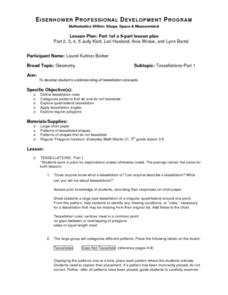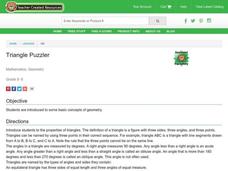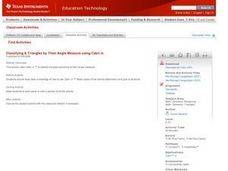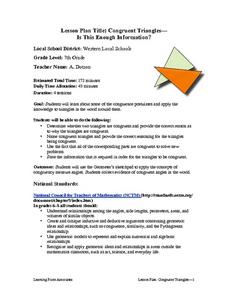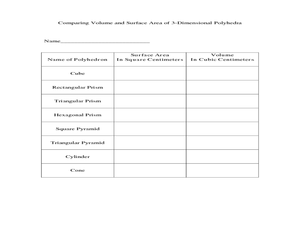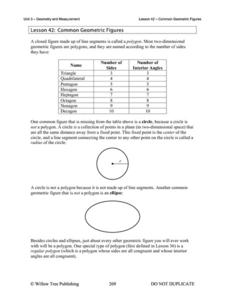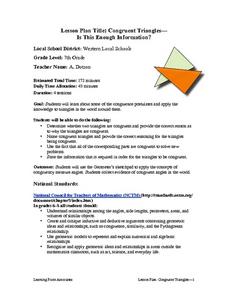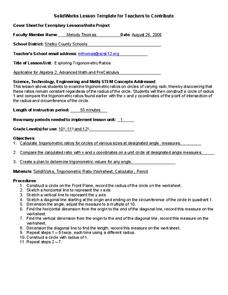Curated OER
Geometry /Tessellations
Learners investigate the concept of tessellations and how they are formed using angles. They categorize how different patterns do and not tessellate and separate them into two different places for assessment. The teacher draws examples...
Curated OER
Triangle Puzzler
Students are introduced to some basic concepts of geometry. They explain that the definition of a triangle is a figure with three sides, three angles, and three points. Triangles can be named by using three points in their correct sequence.
Alabama Learning Exchange
It's Around There Somewhere! Perimeter, and Circumference
Explore the concept of building equations for perimeter and circumference. Learners use rulers to measure the perimeter of half a sheet of paper. Then fold the sheet of paper numerous times, each time measuring perimeter. ...
Curated OER
Are you in Golden Shape
Learners solve and verify the solution for unknown measures. In this geometry lesson, students identify the properties of circles. They use the arc, angle and segment relationship to find the missing measures.
Curated OER
Mathematics Within: Shape, Space & Measurement
Students experiment and analyze triangulation to assess degrees of combined angles, predict polygons that tessellate as well as extending of shapes to create tessellations. They explore the concept of why some polygons tessellate when...
Curated OER
Drawing a Triangle with Cabri Junior
Learners draw triangles on their graphing calculators using the Cabri Junior application. For this graphing calculator lesson, students follow step by step directions to create triangles on their calculator. They identify the type of...
Curated OER
Isosceles Triangle Theorem
In this geometry worksheet, students differentiate between regular triangles and isosceles triangles. They apply the converse theorem and the vertex angle. There are eleven questions with an answer key.
Curated OER
Connecting Formulas Related to Geometric Figures
Young scholars identify diagrams of quadrilaterals and circles by different names and classify the figures. They name the areas for each diagram and practice solving the formulas for each.
Curated OER
Congruent Trianges - Is This Enough Information?
Seventh graders determine whether two triangles are congruent and provide an explanation to why they are not. They apply concepts of measurement of angles and collect evidence of congruent angles in the world.
Curated OER
Pythagorean Theorem
For this geometry worksheet, 10th graders solve for missing sides and angles of a triangle. They use the pythagorean theorem to solve for the unknown in a right triangle. There are 5 questions on this worksheet.
Curated OER
The Value of Volume
Students measure the perimeter and area of their polygons. In this geometry lesson plan, students calculate the volume and area using the correct tools. They calculate the time and temperature and the perimeter and side lengths of...
Willow Tree
Common Geometric Figures
Geometry could be called the study of figures. An overview of the figures found in a typical geometry course contains a study of different triangles, quadrilaterals, and regular polygons.
Curated OER
Pythagorean Theorem
Students discover the Pythagorean Theorem. In this discovering the Pythagorean Theorem lesson plan, students measure the lengths of various triangles to the nearest centimeter. Students record their measurements in a table. ...
Curated OER
Phenomenological Pizza
Young scholars explore measurement in terms of pizza toppings. For this math lesson plan, students draw a circle using string and a ruler, determine areas of different size circles, find how many two topping pizzas can be made using 14...
Curated OER
Algebra 2 & Trigonometry Practice: Law of Sines
In this law of sines worksheet, high schoolers solve 9 multiple choice and short answer problems. Students use the law of sines to missing side lengths and angles of triangles.
Alabama Learning Exchange
The Moon's Craters
Fifth graders investigate the formation and size of impact craters. In small groups, they conduct an experiment that involves dropping marbles into flour and measuring the impact from various heights and discussing their hypothesis and...
Curated OER
That's So Square
Students familiarize themselves with the three most common geometric shapes: circles, triangles and parallelograms. They sketch, sort, and name the shapes.
Curated OER
Congruent Triangles - Is This Enough Information?
Seventh graders examine congruence postulates and apply knowledge to triangles in the world around them.
Illustrative Mathematics
Seven Circles III
A basic set-up leads to a surprisingly complex analysis in this variation on the question of surrounding a central circle with a ring of touching circles. Useful for putting trigonometric functions in a physical context, as well as...
Curated OER
Exploring Trigonometric Ratios
Young scholars calculate the different ratios using a right triangle. In this trigonometry lesson, students identify the sine, cosine and tangent of each side. They find the missing angles using the different ratios.
Curated OER
Plain Figures And Measuring Figures
Seventh graders investigate the mathematical concept of a sector. They apply the concept to an example problem and then move into a more complex application. They find the area of the side of a cone. This is done as students calculate...
Curated OER
Circumscribed Polygons
Students investigate polygons and construct ferris wheels. In this geometry lesson plan, students create a circle and differentiate properties of circles and polygons. They compare the relationship between angles and circumscribed polygons.
Curated OER
2-D Geometry
Third graders describe and compare attributes of two-dimensional shapes. They explain geometric terms, angles and shapes. Students demonstrate each vocabulary word with their body and they mirror the body positions associated with each...
Curated OER
Regular Polygons
Fifth graders explore polygons. In this math instructional activity, 5th graders find examples of regular polygons in the classroom and measure the sides of figures to determine if they are regular polygons.
